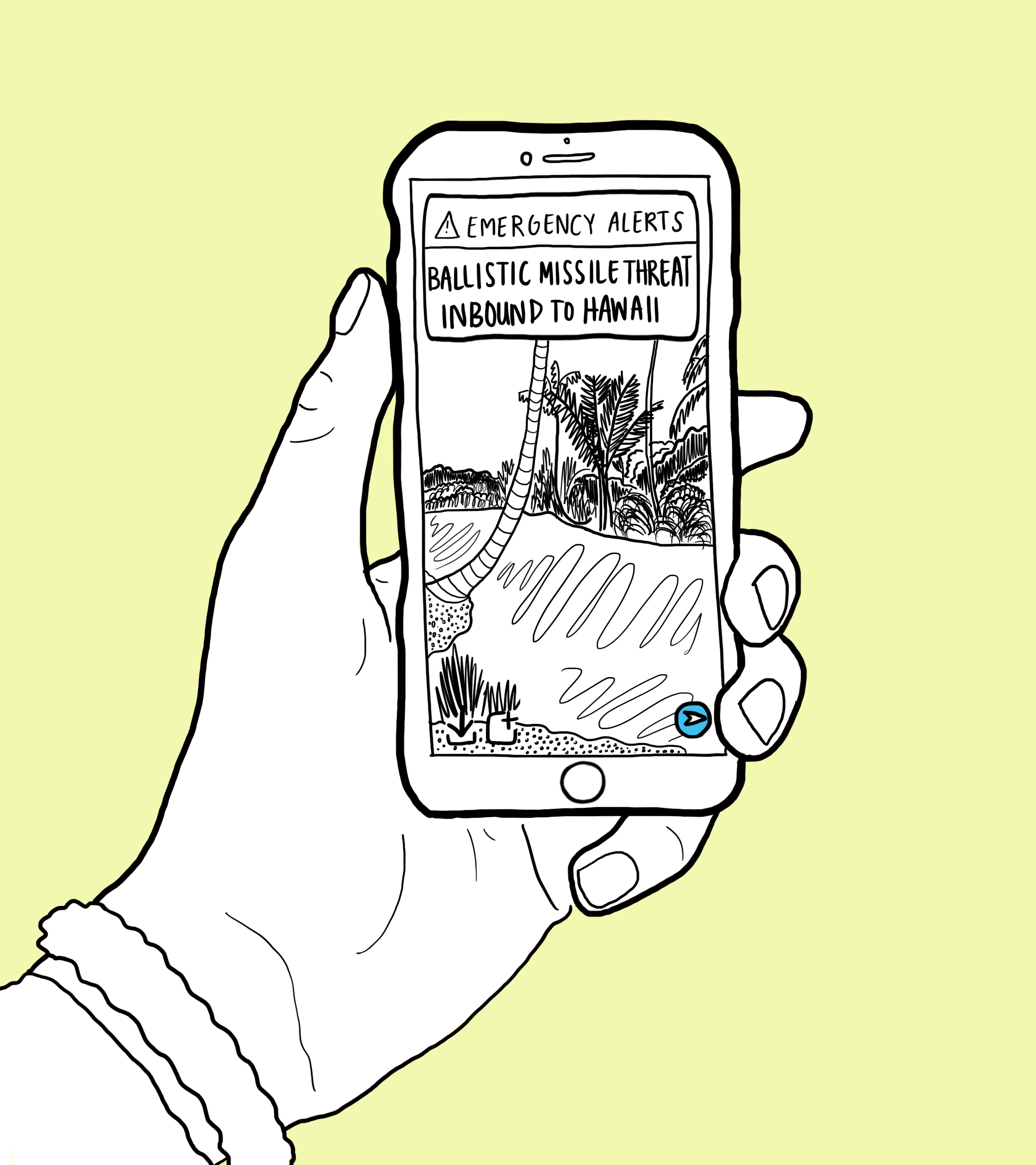Graphic by Natalie Kulak ’21
BY CASEY ROEPKE ’21
After months of conflict and Twitter warfare between President Trump and Kim Jong-un, residents and visitors of Hawaii were greeted by what appeared to be the culmination of North Korea’s nuclear threats: an emergency warning message, reading “BALLISTIC MISSILE THREAT INBOUND TO HAWAII. SEEK IMMEDIATE SHELTER. THIS IS NOT A DRILL.” Thirty-eight minutes later, the Hawaii Emergency Management Agency admitted their mistake, but by then, a panic had already spread across the islands, with many residents fearing for their lives. Although the initial panic has since subsided into jokes, with gift shops selling “I survived the ballistic missile alert” T-shirts, this event legitimized the anxieties of residents within the range of nuclear attacks in the Pacific.
The New York Times reported that Hawaii has been on “high emotional alert” ever since Trump and Jong-un began exchanging threats. The state has monthly air-raid drills to prepare for the 12-minute window to seek refuge in a nuclear attack. Hawaii and other islands in the Pacific are uniquely vulnerable in the event of a nuclear attack because of their inability to seek underground shelter due to the impregnable nature of lava rock and their proximity to North Korea.
Newsweek reported that a North Korean missile could reach Hawaii in less than half an hour, leaving residents with minutes to prepare. Nuclear threats seemed unlikely in the past. President Trump’s inflammatory comments about North Korea and usage of the phrase “fire and fury” to describe the response of the United States to North Korean attacks seems to highlight nuclear warfare as a definite possibility.
But Bryan Nakayama, a visiting instructor in International Relations at Mount Holyoke, says that an unprovoked North Korean nuclear attack would defy historical precedents. “It is historically clear that North Korea’s main motive is regime survival, which means that North Korea is unlikely to unilaterally enter into a situation where that regime is threatened,” said Nakayama.
MIT associate professor of political science, Vipin Narang, tweeted, “POTUS sees alert on his phone about an incoming toward Hawaii, pulls out the biscuit, turns to his military aid with the football and issues a valid and authentic order to launch nuclear weapons at North Korea. Think it can’t happen?” The modern era of mass communication aids residents in remaining informed and ready, but it also allows for more mistakes, like an accidental alert or hacking from a foreign rival.
Hawaii is not the only location threatened by North Korea. The U.S. territory of Guam is also at risk of an attack. The BBC reported that North Korean president Kim Jong-un has considered plans to fire missiles at Guam.
California has also begun preparations for an incoming nuclear attack. On May 3, 2017, NBC News reported on a North Korean propaganda video released by Pyongyong on April 15, which advertised a missile attack on San Francisco. According to Foreign Policy, the Los Angeles Joint Regional Intelligence Center (LAJRIC) released a bulletin, warning officials to prepare nuclear attack response plans to fend off the “catastrophic” effects of a nuclear attack on Southern California. Forbes recognizes Los Angeles as the “most ‘lucrative’ U.S. target within reach of Pyongyang’s missiles” in terms of “the jargon of military planners.” While many Californians are more concerned with local natural disasters, like the fires and mudslides that ripped through the state, some are concerned about the impending nuclear threat. Maggie Kamb ’21 lives in the San Francisco Bay Area, and has had conversations with her family about the nuclear danger of their home.
“When I was younger I would always be worried about natural disasters. I used to sit awake at night waiting for the apocalypse,” Kamb said. Now that she’s in college on the opposite side of the country, she is hyperaware of the distance. “It would be totally crazy and weird to be here at college and have my home in the Bay Area have an actual, real threat of nuclear weapons from North Korea.” As for her fears while being at home, Kamb said, “the strongest thing I have to say is that honestly my priorities lie elsewhere. Although my home in the Bay Area is most at risk, I’m so much more concerned about internal affairs.”
According to Newsweek, on the other side of the Pacific Ocean, Japanese officials do not have the luxury of distance to diminish their anxieties. Residents are growing concerned about their safety and security from a North Korean nuclear attack. North Korea has launched missiles and conducted nuclear bomb tests over Japan, leading many international leaders to criticize such a blatant act of provocation. Newsweek reported that it has been “widely suggested that North Korean provocations of Japan is due to the latter’s status as the main U.S. ally in the region, making a closer target than the ‘real’ enemy across the Pacific.” Japanese Prime Minister Shinzo Abe has expressed interest in altering their pacifist constitution to allow troops to fight abroad, and some are calling for Japan to develop nuclear weapons, according to TIME.
For residents of Japan, nuclear danger manifests itself deeply in the everyday consciousness of Japanese culture.
“We have things called J-alerts,” says Nanaka Kawada ’21, an international student from Gunma, Japan. “[The government] sends messages when a nuclear missile is coming from North Korea.”
However, Kawada stressed that Japanese residents are not living in fear. “Despite such a situation,” Kawada said, “people still need to go to school and work. They live quite a normal life.”

